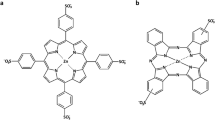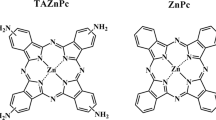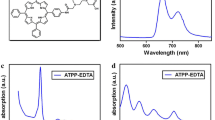Abstract
Two sulfonamide derivatives of porphycene, namely PS6 and PS6A, were synthesized, and their photodynamic efficacies on the nasopharyngeal carcinoma (NPC) cell line NPC/CNE-2 were evaluated. By comparing the 50% lethal concentrations (LC50) of these photosensitizers, we found that PS6A with a cationic ammonium group on the side chain exhibited potent photocytotoxicity on the NPC cell line. At a light dose of 1 J/cm2, the LC50 values of PS6 and PS6A for NPC cells were 11.6 and 1.92 µM, respectively. CNE-2 was found to rapidly take up PS6A in the first hour of incubation, and the uptake kinetics steadily increased to a plateau level after 18 h of incubation. The uptake of PS6A was temperature dependent. Over 99% of CNE-2 cells were sensitized by PS6A 24 h after drug treatment. Collapse of the mitochondrial membrane potential was also observed in PS6A photodynamic therapy (PDT)-treated CNE-2 cells 1.5 h after PDT. Confocal microscopy revealed that PS6A was predominantly localized in the mitochondria, lysosomes and Golgi bodies of NPC cells. Significant genotoxicity was not observed in CNE-2 cells. In functional studies, the in vitro formation of a capillary-like network of human umbilical vein endothelial cells in Matrigel was greatly inhibited by PS6A PDT in a dose-dependent manner. In conclusion, PS6A mediates both in vitro antitumor and antiangiogenic activities. PS6A might be a candidate for photodynamic treatment of NPCs.
Similar content being viewed by others
References
Abels C, Szeimies RM, Steinbach P, Richert C, Goetz AE. Targeting of the tumor microcirculation by photodynamic therapy with a synthetic porphycene. J Photochem Photobiol B 40:305–312;1997.
Bai G, Rama Rao KV, Murthy CR, Panickar KS, Jayakumar AR, Norenberg MD. Ammonia induces the mitochondrial permeability transition in primary cultures of rat astrocytes. J Neurosci Res 66:981–991;2001.
Ball DJ, Vernon DI, Brown SB. The high photoactivity of m-THPC in photodynamic therapy. Unusually strong retention of m-THPC by RIF-1 cells in culture. Photochem Photobiol 69:360–363;1999.
Braslavsky SE, Müller M, Mártire DO, Pörting S, Bertolotti SG, Chakravorti S, Koç-Weier G, Knipp B, Schaffner K. Photophysical properties of porphycene derivatives. J Photochem Photobiol B 40:191–198;1997.
Canete M, Lapena M, Juarranz A, Vendrell V, Borrell JI, Teixido J, Nonell S, Villanueva A. Uptake of tetraphenylporphycene and its photoeffects on actin and cytokeratin elements of HeLa cells. Anticancer Drug Des 12:543–554;1997.
Chen JY, Cheung NH, Fung MC, Wen JM, Leung WN, Mak NK. Subcellular localization of merocyanine 540 (MC540) and induction of apoptosis in murine myeloid leukemia cells. Photochem Photobiol 72:114–120;2000.
Chen JY, Mak NK, Leung WN, Chen SC, Leung KN, Cheung NH. A study of the binding of merocyanine 540 to myeloid leukemia M1 cells using an intensified charge-coupled device for fluorescence imaging microscopy. J Photochem Photobiol B 39:49–55;1997.
Chen JY, Mak NK, Wen JM, Leung WN, Chen SC, Fung MC, Cheung NH. A comparison of the photodynamic effects of temoporfin (mTHPC) and MC540 on leukemia cells: Efficacy and apoptosis. Photochem Photobiol 68:545–554;1998.
Chen JY, Mak NK, Yow CM, Fung MC, Chiu LC, Leung WN, Cheung NH. The binding characteristics and intracellular localization of temoporfin (mTHPC) in myeloid leukemia cells: Phototoxicity and mitochondrial damage. Photochem Photobiol 72:541–557;2000.
Denekamp J. Review article: Angiogenesis, neovascular proliferation and vascular pathophysiology as targets for cancer therapy. Br J Radiol 66:181–196;1993.
Folkman J, Haudenschild C. Angiogenesis in vitro. Nature 288:551–556;1980.
Garbo GM. Purpurins and benzochlorins as sensitizers for photodynamic therapy. J Photochem Photobiol B 34:109–116;1996.
Gottfried V, Davidi R, Averguj C, Kimel S. In vivo damage to chorioallantoic membrane blood vessels by porphycene-induced photodynamic therapy. J Photochem Photobiol B 30:115–121;1995.
Guang-Wu H, Sunagawa M, Jie-En L, Shimada S, Gang Z, Tokeshi Y, Kosugi T. The relationship between microvessel density, the expression of vascular endothelial growth factor (VEGF), and the extension of nasopharyngeal carcinoma. Laryngoscope 110:2066–2069;2000.
Henderson L, Wolfreys A, Fedyk J, Bourner C, Windebank S. The ability of the Comet assay to discriminate between genotoxins and cytotoxins. Mutagenesis 13:89–94;1998.
Kandel J, Bossy-Wetzel E, Radvanyi F, Klagsbrun M, Folkman J, Hanahan D. Neovascularization is associated with a switch to the export of bFGF in the multistep development of fibrosarcoma. Cell 66:1095–1104;1991.
Kessel D. Sites of photodamage by the iminium salt of a copper octaethylbenzochlorin. Photochem Photobiol 58:623–626;1993.
Lemasters JJ, Nieminen AL, Qian T, Trost LC, Elmore SP, Nishimura Y, Crowe RA, Cascio WE, Bradham CA, Brenner DA, Herman B. The mitochondrial permeability transition in cell death: A common mechanism in necrosis, apoptosis and autophagy. Biochim Biophys Acta 1366:177–196;1998.
Luo Y, Chang CK, Kessel D. Rapid initiation of apoptosis by photodynamic therapy. Photochem Photobiol 63:528–534;1996.
Mak NK, Li WK, Zhang M, Wong RN, Tai LS, Yung KK, Leung HW. Effects of euxanthone on neuronal differentiation. Life Sci 66:347–354;2000.
Modica-Napolitano JS, Aprille JR. Delocalized lipophilic cations selectively target the mitochondria of carcinoma cells. Adv Drug Deliv Rev 49:63–70;2001.
Pandey RK, Gang Z. Porphyrin-based photosensitizers for photodynamic therapy. In: Kadish KM, Smith KM, Guilard R, eds. The Porphyrin Handbook. New York, Academic Press, 157–230;2000.
Peng Q, Warloe T, Berg K, Moan J, Kongshaug M, Giercksky KE, Nesland JM. 5-Aminolevulinic acid-based photodynamic therapy. Clinical research and future challenges. Cancer 79:2282–2308;1997.
Qian CN, Min HQ, Lin HL, Feng GK, Ye YL, Wang LG, Kuang ZJ. Anti-tumor effect of angiogenesis inhibitor TNP-470 on the human nasopharyngeal carcinoma cell line NPC/HK1. Oncology 57:36–41;1999.
Qian CN, Min HQ, Lin HL, Hong MH. Combination of angiogenesis inhibitor TNP-470 with cytotoxic drugs in experimental therapy of nasopharyngeal carcinoma. Ann Otol Rhinol Laryngol 109:641–645;2000.
Qian CN, Min HQ, Lin HL, Hong MH, Ye YL. Primary study in experimental antiangiogenic therapy of nasopharyngeal carcinoma with AGM-1470 (TNP-470). J Laryngol Otol 112:849–853;1998.
Richert C, Wessels JM, Muller M, Kisters M, Benninghaus T, Goetz AE. Photodynamic antitumor agents: Beta-methoxyethyl groups give access to functionalized prophycenes and enhance cellular uptake and activity. J Med Chem 37:2797–2807;1994.
Ridge JA. Squamous cancer of the head and neck: Surgical treatment of local and regional recurrence. Semin Oncol 20:419–429;1993.
Sheibani N, Newman PJ, Frazier WA. Thrombospondin-1, a natural inhibitor of angiogenesis, regulates platelet-endothelial cell adhesion molecule-1 expression and endothelial cell morphogenesis. Mol Biol Cell 8:1329–1341;1997.
Shu CH, Shiau CY, Chi KH, Yen SH, Li WY. Salvage surgery for recurrent nasopharyngeal carcinoma in anterior marginal miss after radiotherapy. Otolaryngol Head Neck Surg 121:622–626;1999.
Sizhong Z, Xiukung G, Yi Z. Cytogenetic studies on an epithelial cell line derived from poorly differentiated nasopharyngeal carcinoma. Int J Cancer 31:587–590;1983.
Sternberg ED, Dolphin D. Porphyrin-based photosensitizers for use in photodynamic therapy. Tetrahedron 54:4151–4202;1998.
Sun ZQ. Hematoporphyrin derivative (HPD) plus laser photodynamic therapy for nasopharyngeal carcinoma — analysis of 57 cases (in Chinese). Zhonghua Zhong Liu Za Zhi 12:120–122;1990.
Szeimies RM, Karrer S, Abels C, Steinbach P, Fickweiler S, Messmann H, Baumler W, Landthaler M. 9-Acetoxy-2,7,12,17-tetrakis-(beta-methoxyethyl)-porphycene (ATMPn), a novel photosensitizer for photodynamic therapy: Uptake kinetics and intracellular localization. J Photochem Photobiol B 34:67–72;1996.
Taswell C. Limiting dilution assays for the determination of immunocompetent cell frequencies. I. Data analysis. J Immunol 126:1614–1619;1981.
Toledano H, Edrei R, Kimel S. Photodynamic damage by liposome-bound porphycenes: Comparison between in vitro and in vivo models. J Photochem Photobiol B 42:20–27;1998.
Tong MC, van Hasselt CA, Woo JK. Preliminary results of photodynamic therapy for recurrent nasopharyngeal carcinoma. Eur Arch Otorhinolaryngol 253:189–192;1996.
Vogel E, Balci M, Pramod K, Koch P, Lex J, Ermer O. 2,7,12,17-Tetrapropylporphycene — pendant of octaethylporphyrin in the porphycene series. Angew Chem Int Ed 26:928–931;1987.
Wakisaka N, Wen QH, Yoshizaki T, Nishimura T, Furukawa M, Kawahara E, Nakanishi I. Association of vascular endothelial growth factor expression with angiogenesis and lymph node metastasis in nasopharyngeal carcinoma. Laryngoscope 109:810–814;1999.
Wyld L, Reed MW, Brown NJ. The influence of hypoxia and pH on aminolaevulinic acid-induced photodynamic therapy in bladder cancer cells in vitro. Br J Cancer 77:1621–1627;1998.
Yow CM, Chen JY, Mak NK, Cheung NH, Leung AW. Cellular uptake, subcellular localization and photodamaging effect of temporfin (mTHPC) in nasopharyngeal carcinoma cells: Comparison with hematoporphyrin derivative. Cancer Lett 157:123–131;2000.
Yow CM, Mak NK, Szeto S, Chen JY, Lee YL, Cheung NH, Huang DP, Leung AW. Photocytotoxic and DNA damaging effect of temoporfin (mTHPC) and merocyanine 540 (MC540) on nasopharyngeal carcinoma cell. Toxicol Lett 115:53–61;2000.
Author information
Authors and Affiliations
Rights and permissions
About this article
Cite this article
Mak, NK., Kok, TW., Wong, R.NS. et al. Photodynamic activities of sulfonamide derivatives of porphycene on nasopharyngeal carcinoma cells. J Biomed Sci 10, 418–429 (2003). https://doi.org/10.1007/BF02256433
Received:
Accepted:
Issue Date:
DOI: https://doi.org/10.1007/BF02256433




